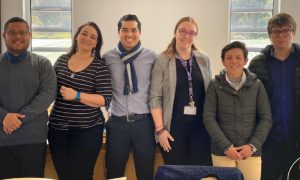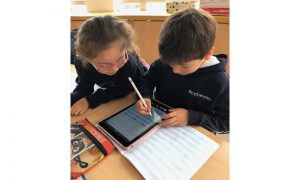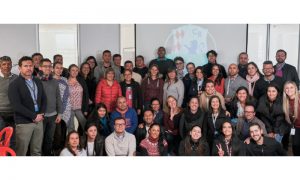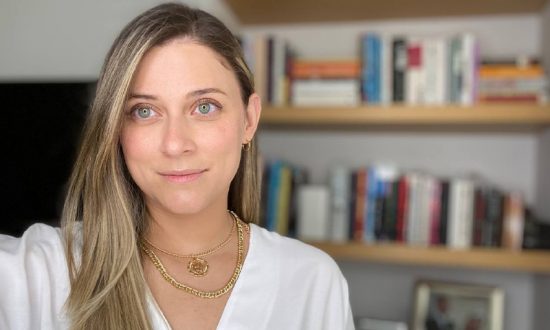Natalia is a published children’s books author, Apple Distinguished Educator, Google Certified Educator, Common Sense Educator, digital learning consultant & coach. She believes in kindness, collaboration, connection, and the power of a meaningful relationship between technology, teacher, student, and learning. As a Bachelor in Early Childhood Educator, and more than 10 years of teaching experience from preschool to college level, Natalia has led educational boards, teachers, and parents in the design and implementation of long-term transformational plans in schools. Always keeping in mind learning as the ultimate goal, Natalia believes technology is a fundamental tool that provides wonderful insight and possibilities if approached correctly. She currently podcasts for school leadership, consults for schools, coaches and mentors teachers in the path of becoming 21st century educators.
Back in 2015 when I became an Apple Distinguished Educator, I felt a spark come to life as an ever clear life purpose: inspire, educate, innovate. This is when I first thought that even though I loved teaching and being in the classroom, the impact of innovation and inspiration could be greater if I could focus on multiplying the edtech vision in schools, rather than one classroom at a time.
As I transitioned out of the classroom, I decided to partner with field experts in the edtech sector, and ideate our very own consulting proposition to fulfill the vision of edtech as a catalyzer for deeper and more effective learning opportunities for all. To build something as ambitious from scratch was indeed a challenge, but an exciting one at that. This is how eDnovating was born: at a dinner table with educators who loved technology and believed it to be the game changer in the future of education.
A successful implementation of school-wide edtech is what we set out to do with Rochester School. It needs to begin with a clear proposal: drive the school to fully integrate Apple technology, from teacher iPads and Macs, to student devices, and labs. From a technology standpoint this meant many structural and technical challenges. However, from a pedagogical view, the roadmap would require years to fulfill. We therefore set out on a task to fully understand what Rochester School was like at that point.
In order to gain deeper insight, a full blown diagnostic of the teaching and learning culture needed to take place. Everything from informal conversations to formal class observations, allowed us to understand how to best serve the community and plan accordingly for the upcoming years. Implementing a root cause analysis, was crucial for the plan to be successful and to decrease pushback as much as possible.

Understanding the complexities of an educational organization is not an easy task. It requires grit, empathy, structure, charisma, and an array of people skills. People drive education, so in order to understand the institution, you need to know the people. This is why we set out to create a task force represented by the different leaders of the institution in order to get our plan going: learning, teaching, leading, technology, and infrastructure were represented by 5 leaders who would allow the task force to provide guidance in their field to their peers.
The task force strategy, paired with one to one interviews, surveys, and class observations, allowed us to design a robust action plan. It was very pleasing to find a school with a growth mindset culture, characterized by a focus on continuous professional development, self and peer evaluation and a clear educational philosophy which had technology as one of the main tools to help materialize the educational vision.
We also found plenty of room for growth. From professional development, to the purchase of devices, we set out to cover as much ground as possible through the leadership of our tTask force.
In learning, we focused on the curriculum. Deploying a curriculum analysis and integration of ISTE Student Standards throughout K12, being mindful of the suggested bands, as well as intricacies like the amount of learning expectations a teacher had to balance and assess throughout each trimester and year. This was a deep challenge that was carried out with all area heads, so they could grasp the concepts that would later on be expected to be deployed throughout the year.
When it came to Teaching, we focused on professional development. What do teachers need to know, and know how to do in order for them to successfully lead and facilitate the best learning experiences with technology? The clear growth mindset allowed for the leadership to open up the professional learning opportunities throughout three years, designing a school certification process in which we involved digital literacy skills, and digital pedagogy. Teachers learned how to use the tools through the Apple Teacher certification process, and developed planning and implementation skills in blended scenarios through the eDnovator certification we provide.
Leadership focused on providing the vision and the resources to make all the other actions happen. By allocating resources in the shape of money, people, time, permission to take risks, and providing emotional support, the other teams were able to design and follow a vision with clear guidelines.
Technology was a different conversation. Many people focus only on the devices, but when we talk about Edtech, there are many factors to consider. We looked into platforms, apps, learning analytics, classroom observation tools, and how each investment would greater support learning and the success of children in the school. This is a conversation that should always be guided by the pedagogy, and never by IT. It is crucial to remember that every investment a school makes, should help gain in student success, and therefore having the pedagogy lead the decision making of the tools is a game changer.
Finally, the backbone of every technology implementation lies with the IT department. They are the ones that make the teaching and learning magic possible for the rest of the community. Making sure that the school was well equipped with its network, access points, routers, LMS, SIS, MDM, etc. was fundamental and it was precious groundwork that was carried out.

Despite drafting a rigorous path, it is always crucial to remain flexible. This is why we hold it as one of our core values and embed it in our methodology. Setting up an action plan, strategies, specific KPIs, responsible persons, expected products, and available resources helps the strategic plan come together in a cohesive fashion for everyone involved to understand it. But when dealing with people, it is always recommended to expect pushback and the need to regroup and come with different solutions as the plan is ongoing. In synthesis: people are key in edtech implementations. Which leads me to the next important aspect of the plan: socializing.
Once the plan had taken its shape and form, we were ready to share it to the school community. This is a key moment, because you will commit yourself to follow through with the plan for the next three years, and to guarantee that everything in the leaderships’ power will be done to guarantee that it will be successful. It is also a beautiful part of the experience, seeing how hope and excitement vibrates throughout the community around a project that impacts students’ possibilities in such a profound way. Also, involving the community in the plan helps increase people’s investment towards the common goals that are being planned for.
It was very interesting to sort out the challenges along the way. Because, yes, there were challenges and many. With resilience, teamwork and flexibility we managed to continue meeting our KPIs and developing the plan even further as time passed. We discovered that professional development had been key, and that our strategic plan would have been at a loss had the teachers not had the opportunity to learn how to use the iPads, and how to teach and learn with them. It wasn’t only the teachers and leadership that received training, the IT staff also received training in different subjects in order for them to be able to make the experience for everyone possible.

As time went by, we expanded the reach of the program, including parents in the mix with initiatives like the “Digital Parents Blog”, where they received a weekly message with tips onrelated to how to parent in the 21st century. Also, special training sessions took place to empower parents in the use of parental controls at home, and all around parenting tools.
Nowadays, when you walk by the buildings, you will find students that will halt you and ask your for an interview, which they are conducting on their iPads. And I’m talking about third and fourth graders, sometimes even our preschoolers will do it. You will find stop motion, green screen, podcasts, digital music and photography happening all around you, allowing students to express their learning using technology as the prime tool to make their learning visible. You will see students collaborating online, or even next to each other as they figure out the script to their movie, or the structure of the photo collage. You will find students who collaborate to create, and use technology to produce rather than to consume, actively engaged in their processes and showing leadership and autonomy in their learning.
Now we are looking at a different phase. We want to expand the use of technology to other grades: Preschool and lower Elementary. Though the use here has been conservative, you can still see students using robots to learn prepositions, iPad apps to learn how to trace letters and discover the world of phonics. We wish to continue providing students with more interdisciplinary elements in their projects in order to push toward a high order thinking skills (HOTS) mindset. Also, the STEM Lab is in the oven.
When we look back it seems like not a lot of time has passed, but five years in the making is a long time, and we can see the ripening of our efforts. What began as a three year partnership, has extended, allowing us to continue providing guidance, support, a hand, two hands, a heart, and all the minds we can put together to solve problems creatively and most importantly: as a team of educators who will go the long mile for their students.




